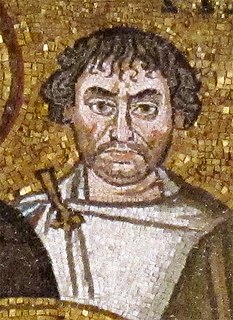Related Research Articles
The 550s decade ran from January 1, 550, to December 31, 559.

Year 553 (DLIII) was a common year starting on Wednesday of the Julian calendar. The denomination 553 for this year has been used since the early medieval period, when the Anno Domini calendar era became the prevalent method in Europe for naming years.

Narses was, with Belisarius, one of the great generals in the service of the Byzantine Emperor Justinian I during the Roman reconquest that took place during Justinian's reign. Narses was a Romanized Armenian. He spent most of his life as an important eunuch in the palace of the emperors in Constantinople.

Totila, original name Baduila, was the penultimate King of the Ostrogoths, reigning from 541 to 552 AD. A skilled military and political leader, Totila reversed the tide of the Gothic War, recovering by 543 almost all the territories in Italy that the Eastern Roman Empire had captured from his Kingdom in 540.

At the Battle of Taginae in June/July 552, the forces of the Byzantine Empire under Narses broke the power of the Ostrogoths in Italy, and paved the way for the temporary Byzantine reconquest of the Italian Peninsula.
Teia, also known as Teja, Theia, Thila, Thela, and Teias, was the last Ostrogothic King of Italy. He led troops during the Battle of Busta Gallorum and had noncombatant Romans slaughtered in its aftermath. In late 552/early 553, he was killed during the Battle of Mons Lactarius. Archaeological records attesting to his rule show up in coinage found in former Transalpine Gaul.

The Battle of Mons Lactarius took place in 552 or 553 during the Gothic War waged on behalf of Justinian I against the Ostrogoths in Italy.

The Gothic War between the East Roman (Byzantine) Empire during the reign of Emperor Justinian I and the Ostrogothic Kingdom of Italy took place from 535 until 554 in the Italian peninsula, Dalmatia, Sardinia, Sicily and Corsica. It was one of the last of the many Gothic Wars with the Roman Empire. The war had its roots in the ambition of the East Roman Emperor Justinian I to recover the provinces of the former Western Roman Empire, which the Romans had lost to invading barbarian tribes in the previous century.

A Struggle for Rome is a historical novel written by Felix Dahn.
The Battle of the Volturnus, also known as the Battle of Casilinum or Battle of Capua, was fought in 554 between an army of the Byzantine Empire and a combined force of Franks and Alemanni. The Byzantines, led by the old eunuch general Narses, were victorious.
Artabanes was an East Roman (Byzantine) general of Armenian origin who served under Justinian I. Initially a rebel against Byzantine authority, he fled to the Sassanid Persians but soon returned to Byzantine allegiance. He served in Africa, where he won great fame by killing the rebel general Guntharic and restoring the province to imperial allegiance. He became engaged to Justinian's niece Praejecta, but did not marry her due to the opposition of the Empress Theodora. Recalled to Constantinople, he became involved in a failed conspiracy against Justinian in 548/549, but wasn't punished severely after its revelation. He was soon pardoned and sent to Italy to fight in the Gothic War, where he participated in the decisive Byzantine victory at Casilinum.
Chanaranges was a Byzantine military officer, active in the late reign of Justinian I. He was an Armenian and his name is occasionally rendered as Charanges. He is only known for his activities in the Gothic War, in particular the Battle of the Volturnus in 554. The main source about him is Agathias. The name probably derives from Kanārang, a military title of the Sassanid Empire. He should probably not be confused with his contemporary, the Chanaranges who took part in the conspiracy of Artabanes.
Justin was a 6th-century East Roman (Byzantine) general, who was active in the Gothic War in Italy under Justinian I.
John, the nephew of the rebel Vitalian, was an Eastern Roman general under Justinian I, who was active in the Gothic War in Italy and against the Gepids in the western Balkans. He was married to Justina, the daughter of Justinian's cousin Germanus.
Indulf, also known as Gundulf, was a Byzantine mercenary who defected to the Ostrogoths and became a leader in their army in the last years of the Gothic War of 535–554.
Bessas was an East Roman (Byzantine) general of Gothic origin from Thrace, primarily known for his career in the wars of Justinian I. He distinguished himself against the Sassanid Persians in the Iberian War and under the command of Belisarius in the Gothic War, but after Belisarius' departure from Italy he failed to confront the resurgent Goths and was largely responsible for the loss of Rome in 546. Returning east in disgrace, despite his advanced age he was appointed as commander in the Lazic War. There he redeemed himself with the recapture of Petra, but his subsequent idleness led Justinian to dismiss him and exile him to Abasgia.
Ragnaris was a Hunnic warlord who fought for the Ostrogoths in the final stages of the Gothic War against the Eastern Roman Empire. Procopius calls him a Goth, but the better informed Agathias records that he was of the Hunnic tribe of the Vittores or Vitgores.
Coccas was an Eastern Roman soldier who deserted to the Ostrogoths during the final stages of the Gothic War. Procopius calls him "a Roman soldier" and "a man of the Gothic army". His name is not Germanic, and might be Thracian.
Asbadus was a Gepid leader fighting for the Eastern Roman Empire against the Ostrogoths in the final stages of the Gothic War.
Scipuar was a commander of the Ostrogoths in the final stages of the Gothic War against the Eastern Roman Empire.